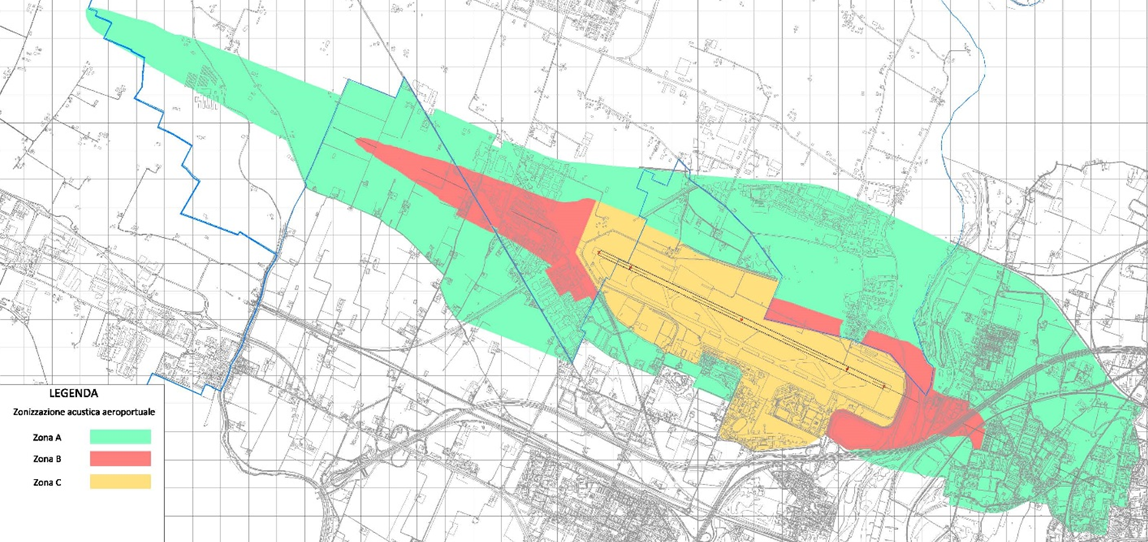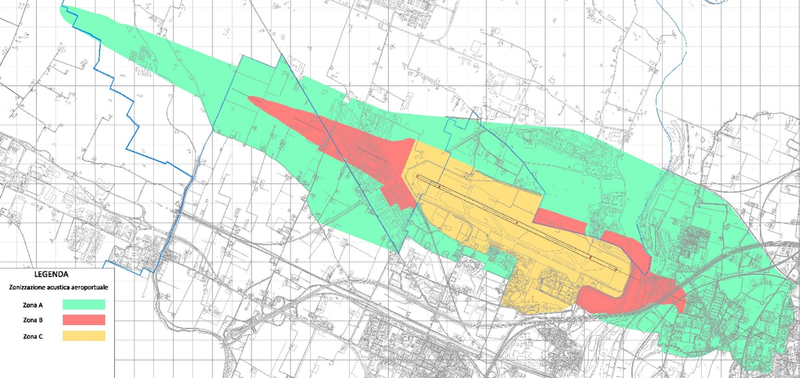What is airport noise?
Airport noise is the main environmental impact to affect people living near airports. The source of the noise pollution is the aircraft, which create engine and drag noise during take-off and landing. The level of air traffic noise perceived on the ground depends on various factors, such as the number and type of aircraft, the overflight altitude, the route taken and, last but not least, the weather conditions.
How airport noise is measured
Bologna Airport has a noise monitoring system that complies with legislation, composed of seven fixed sound level meters positioned under the landing and take-off paths of the aircraft. Each sound level meter detects the noise produced by the aircraft flying over and transmits the data to the central system to calculate the overall noise. The system also acquires the radar tracking data supplied by ENAV, which is cross-referenced with the noise data transmitted by the sound level meter, to calculate aircraft noise.
How airport noise is managed
Bologna Airport, together with the responsible bodies and authorities, implements specific noise management measures aimed at mitigating noise impact and reducing the disturbance caused to the surrounding communities, with specific regard to flights over the residential areas to the east of the airport. The airport noise management initiatives are in line with the main international guidance (Balanced Approach set out in European Directive 2002/30/EC).
- Technological evolution
- Land-use planning (Airport Noise Zones)
- Noise mitigation procedures and operating restrictions
The assessment and implementation of the noise management measures is the responsibility of the Airport Commission, established pursuant to Italian Ministerial Decree of 31/10/1997. It is chaired by ENAC and includes representatives of the following bodies: the Italian Ministry of the Environment (ISPRA), the Emilia-Romagna Region, the Metropolitan City of Bologna, the Municipality of Bologna, the Municipality of Caldera di Reno, the Municipality of Anzola Emilia, ARPAE, the Airport Manager, ENAV and the airlines.
Technological evolution
A key aspect of managing the impact of airport noise is the reduction of aeroplane noise at source. Since the 1970s, passenger aircraft have been subject to noise certification standards, called “Chapters”, assigned by applying ICAO (International Civil Aviation Organisation) criteria. Originally, all aircraft were “Chapter 2” aeroplanes, but thanks to technological progress, aeroplane noise has gradually been reduced with the introduction of “Chapter 3” and “Chapter 4” aircraft.
Land-use planning
Reducing the impact of noise on the local population cannot be achieved without adequate land-use planning. Italian legislation requires that so-called “airport noise zones”, consisting of three compliance bands (A, B and C), be defined for every passenger airport. Each band is characterised by airport noise limits and by use of the land concerned. Specifically:
- Zone A: the outermost zone around the airport; airport noise may not exceed 65 decibels, calculated based on the peak period of an entire calendar year, and there are no restrictions on land use;
- Zone B: the middle zone, where airport noise may not exceed 75 dB and no new housing developments are permitted;
- Zone C: the zone closest to the airport and therefore the noisiest; no noise limits are in force in this zone and only residential activities related to the function of the airport are permitted.
The Bologna Airport noise zones are shown in the following figure.

Noise mitigation procedures and operating restrictions
Noise mitigation procedures and operational restrictions are in place at Bologna Airport to limit air traffic over the centre of Bologna and, therefore, to minimise the impact on local residents. In particular, ENAC Ordinance No. 5/2023 (in force since 19 June 2023, updating the previous Ordinance 11/2016) sets out specific conditions for the use of runways for take-off and landing at night (23:00 - 06:00) and during the day (06:00 - 23:00)
Nighttime (23:00 - 06:00)
- from 23:00 to 06:00 LT take-offs must take place from runway 30 unless otherwise requested by the pilot for weather or safety reasons;
- from 23:00 to 06:00 LT landings must take place on runway 12 unless otherwise requested by the pilot for weather or safety reasons.
Thus, the runway's nighttime hourly capacity is half that of daytime. All take-offs and landings must be in the direction of Bargellino (Runway 30 take-offs) and coming from Bargellino (Runway 12 landings) respectively, even at the cost of possible delays in departures and landings, unless weather or safety conditions preclude it.
Daytime (06:00 - 23:00)
From 06:00 to 23:00 LT take-offs take place preferably from runway 30, unless for ATC reasons or the pilot requests otherwise for weather and safety reasons.
Thus, during the daytime, the use of runways shall be determined with a view to ensuring flight safety while also minimising any delays due to the occupation of airspace.
In compliance with national regulations, noise mitigation procedures and operational restrictions do not apply to state aircraft, military flights, humanitarian flights, search and rescue flights, or any flights authorised by the Italian Civil Aviation Authority.

The weather or safety reasons specified in the ENAC Ordinances relate to the conditions described below.
- LVP (Low Visibility Procedures): these are international operating procedures adopted during low visibility conditions to enable aircraft to take off and land in complete safety. When the Low Visibility Procedures are in place, aircraft may only take off from and land on Runway 12.
- Wind: Aircraft must take off and land in a headwind against its direction of movement to ensure adequate aerodynamic lift and, thus, flight safety. Air traffic is therefore coordinated considering the wind speed and direction recorded.
- Bad weather: this is defined as adverse meteorological conditions at different altitudes, both at ground level and at high altitude, which may require aircraft to approach or depart from a particular direction.
- Infrastructure Limitations: these are conditions where maintenance activities are ongoing in aircraft movement areas (runways, aprons, taxiways) that temporarily limit or restrict operations or prevent the use of certain take-off/landing runs; other infrastructural limitations concern the specific characteristics of the aircraft which, due to its size and weight, needs to operate in a specific direction of movement).
- ATC reasons: these are conditions where the direction of take-off and landing is constrained by the need to ensure appropriate physical separation and regularity of air traffic. This condition is laid down in the ENAC Ordinances for daytime only.
- Former ENAC Ord. 11/2016:concerning take-offs and landings for night flights over Bologna, which, due to the occupation of airspace, must contain delays to within 20 minutes. Article 1 of Order 11/2016 is suspended until 31 October 2023, replaced by Article 1 of Order ENAC 05/2023.
- Pilot's request due to weather or safety reasons: requests from aircraft flight crew due to the weather (e.g. different meteorological conditions on the two different areas of the ground concerned and/or to avoid bad weather/storms/turbulence/wind shear), or due to the operational performance of the aeroplane (which affects the safety of take-off/landing, such as aircraft weight/available runway length/wind conditions/runway slope/runway contamination), or due to radio aids/available instrument procedures.
A precise analysis and subsequent publication of all landings and take-offs in the night time slot (23:00 - 06:00) occurring in the direction of Bologna is performed to provide timely information on the application of ENAC Ordinances.



-1.jpg)


-2.jpg)


